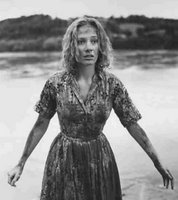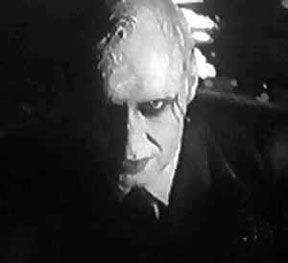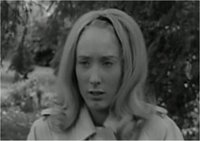
For years I thought that the abandoned amusement park in Herk Harvey's Carnival of Souls (1962) was in Kansas; but this morning I checked the IMDb, which informs us that it was actually something called the Saltair Amusement Park, located outside Salt Lake City. And watching the movie again, the place does have a salt-flat feel to it, with a broad oily pool of water stretching at its feet. Utah it is, then.
Of course, though, what matters most about Carnival of Souls is the almost entirely internalized geography it spreads before us, the shadowland of Mary Henry's*--not "mind," because, from the moment of her cooly observed emergence from the water--the drag-racing car she rode in plunging over a bridge--Mary slips away from us, closer to the pallid face and pale invitation of the Other Side. So maybe it is the geography of her refusal to die, to admit she is not so much being pursued by ghosts as reclaimed by them. A church organist without faith, she fades (as do the sounds and human contact of the world around her), fluttering like a small bird held in soft, cold hands.
 Where did this movie come from? Well, if you go to Herk Harvey's entry in Wikipedia, you'll discover he was a theater major who entered the industrial/educational film business in Lawrence, Kansas (and so this is why I thought Carnival's abandoned pavilion was located in Lawrence). He worked for Centron films for over thirty years, first as an actor and then as a director and/or producer, with titles such as The Sound of a Stone (1955) (Methodist-Church-funded anti-McCarthy film), Why Study Home Economics? (1955) (I'm sure they offered numerous convincing reasons), Manners in Public (1958) (short answer: You should have them), Oxidation Ditches: One Answer to Manure Disposal (1970) (some titles write their own jokes), and, with a title almost as unsettling as his one feature film, Pork: The Meal with a Squeal (1977). Carnival of Souls, though, was an intensely personal project, and his fascination with the idea of a dance of the dead allowed him to build a mood piece of surprising resonance. I will not dwell on its high reputation as a "cult film"; what matters for me is that I first saw it with little fanfare--an image of the white-faced Man was enough to get me interested--and immediately saw both its flaws (for my taste a bit too heavy on the organ music--then again, it fits the plot in a way other horror-movie organ scores do not--and some stiff (heh-heh-heh) acting) and its lasting strength: as an almost cruelly impartial observation of a nightmare, with its matter-of-fact slow decline, its relentless delivery of Mary into the hands of her fellow dead. It begins with the simple fact of universal mortality, and refuses to provide any reprieve.
Where did this movie come from? Well, if you go to Herk Harvey's entry in Wikipedia, you'll discover he was a theater major who entered the industrial/educational film business in Lawrence, Kansas (and so this is why I thought Carnival's abandoned pavilion was located in Lawrence). He worked for Centron films for over thirty years, first as an actor and then as a director and/or producer, with titles such as The Sound of a Stone (1955) (Methodist-Church-funded anti-McCarthy film), Why Study Home Economics? (1955) (I'm sure they offered numerous convincing reasons), Manners in Public (1958) (short answer: You should have them), Oxidation Ditches: One Answer to Manure Disposal (1970) (some titles write their own jokes), and, with a title almost as unsettling as his one feature film, Pork: The Meal with a Squeal (1977). Carnival of Souls, though, was an intensely personal project, and his fascination with the idea of a dance of the dead allowed him to build a mood piece of surprising resonance. I will not dwell on its high reputation as a "cult film"; what matters for me is that I first saw it with little fanfare--an image of the white-faced Man was enough to get me interested--and immediately saw both its flaws (for my taste a bit too heavy on the organ music--then again, it fits the plot in a way other horror-movie organ scores do not--and some stiff (heh-heh-heh) acting) and its lasting strength: as an almost cruelly impartial observation of a nightmare, with its matter-of-fact slow decline, its relentless delivery of Mary into the hands of her fellow dead. It begins with the simple fact of universal mortality, and refuses to provide any reprieve.  And it is beautifully shot (make sure that you're watching the Criterion DVD; Netflix sent me an inferior print), its lighting and camera placement remarkable--well, OK, perfect. This is a movie that looks exactly the way it needs to, that manages to bypass its weaknesses--even overcome them--simply by looking at its subject without blinking. As the dead rise from the black water, or dance in fast-motion--without any attendant silliness--and as Mary flees under the dark skies and shadowed streets, as the camera looks over, down and up, always holding just long enough to see, but not to break the mood, Carnival of Souls joins the short list of films that move like dreams. Its very detachment becomes an invitation to the danse macabre, and its slim resources force us into the narrow passage Harvey demands we follow, back to the car wreck, the spit of sand, and the thing we've known all along, but had to be told--because we want it so little: that Mary needs to go the way of all flesh. It is a movie that, like Thomas Gray's poetry, tells me to see the world as a graveyard, and ultimately is not so much cruel as clear in that vision; in the end, almost with kindness, it "leaves the world to darkness and to me."
And it is beautifully shot (make sure that you're watching the Criterion DVD; Netflix sent me an inferior print), its lighting and camera placement remarkable--well, OK, perfect. This is a movie that looks exactly the way it needs to, that manages to bypass its weaknesses--even overcome them--simply by looking at its subject without blinking. As the dead rise from the black water, or dance in fast-motion--without any attendant silliness--and as Mary flees under the dark skies and shadowed streets, as the camera looks over, down and up, always holding just long enough to see, but not to break the mood, Carnival of Souls joins the short list of films that move like dreams. Its very detachment becomes an invitation to the danse macabre, and its slim resources force us into the narrow passage Harvey demands we follow, back to the car wreck, the spit of sand, and the thing we've known all along, but had to be told--because we want it so little: that Mary needs to go the way of all flesh. It is a movie that, like Thomas Gray's poetry, tells me to see the world as a graveyard, and ultimately is not so much cruel as clear in that vision; in the end, almost with kindness, it "leaves the world to darkness and to me." *Played by Candace Hilligoss, looking, don't you think, like Judith O'Dea, the immortal--and equally stunned--"Barbra" in the original Night of the Living Dead. Always coming to get you, yes?
*Played by Candace Hilligoss, looking, don't you think, like Judith O'Dea, the immortal--and equally stunned--"Barbra" in the original Night of the Living Dead. Always coming to get you, yes?
No comments:
Post a Comment